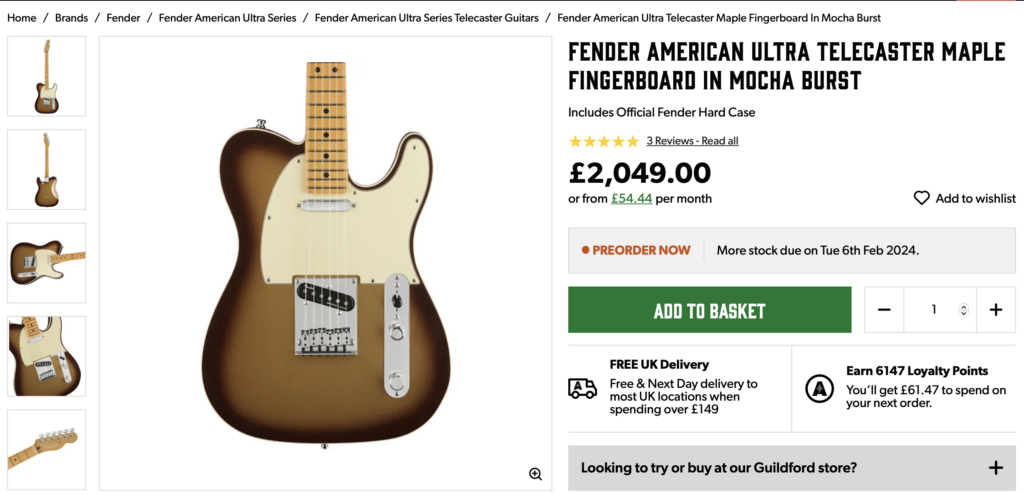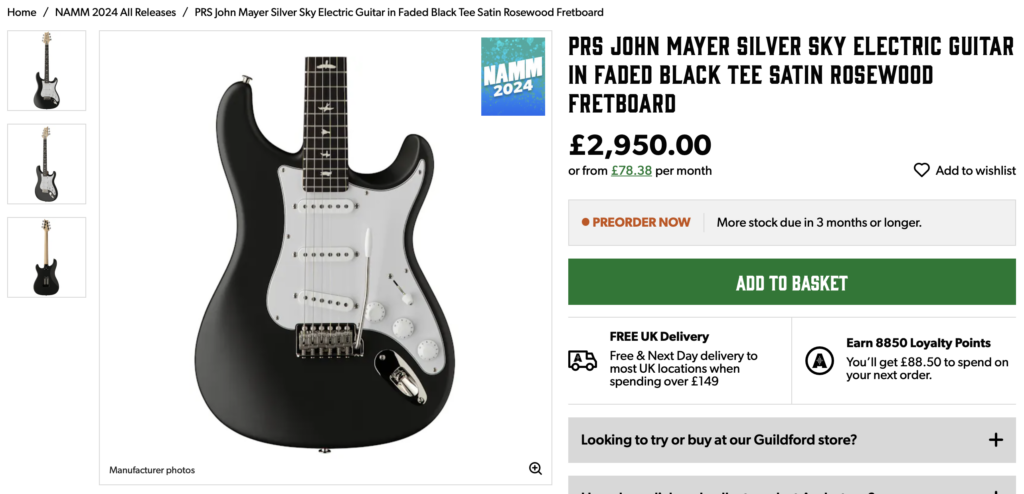#CoffeeAndKlon is my (irregular!) Sunday morning magazine series, where I talk about whatever’s on my mind right now. There’s always coffee, and there’s normally chat about the Klon and its many competitors.
When I started writing this, Winter NAMM 2024 had just kicked off, and my inbox was full of my favourite guitar stores sending out links to their pre-order product pages. Out of curiosity, I clicked through to the Andertons page to take a look …
… and my jaw hit the floor at just how expensive new gear has become.
But was my reaction right, or was it just a reflection of how hard general inflation has affected all prices in the last few years? I’m going to explore that today.
Table of Contents
- Today’s Coffee
- This Post Is Not A Dig At Andertons
- What I’m Comparing To
- How Much Has Money Actually Devalued?
- Limited Edition Fender Ultra Stratocaster
- Fender Ultra Telecaster
- PRS Silver Sky
- What About Gibson’s Pricing?
- So What Have I Learned From This?
- The Golden Age Of Gear Is Coming To An End
- Final Thoughts
Today’s Coffee
This weekend, we’re finishing off the last of our Columbian coffee beans. I’m a huge fan of this coffee. I just wish it was easier to get.
Over the last few months, coffee beans have been disappearing from supermarket shelves over here. We used to have a lot of choice, but the big supermarkets have been stuffing the shelves with more and more of those hated coffee pods recently.
(I say hated because so many of them aren’t recyclable at all; the empty husks just go straight to landfill 🤬)
I don’t know why our supermarkets are doing this, only that they’re all doing this.
We’re almost at the point where we’ll either have to start ordering coffee beans online, or start making a special trip every month to go and buy our beans from a specialist store. (We have a local coffee beans store in town, but they’ve also stopped stocking most of the coffee beans they used to sell 🙁).
Before you say anything, yeah I know #FirstWorldProblems and all that … but this is part of an overall trend of enshitification that we’ve been hit with during the cost of living crisis. We’re not just paying a lot more for a lot less: whole product lines are disappearing, leaving us impoverished both in choice and in money.
This Post Is Not A Dig At Andertons
Let’s just get this out the way first.
I’m going to mention Andertons a lot today, simply because they had all the products priced up and online as NAMM started. Don’t, for one minute, think I’m calling out Andertons for their pricing. I’m not. You’ll find pretty much the same pricing wherever you look in the UK.
It’s just easier to look for prices in the one place.
In my experience, most guitar stores in the UK sell new products at pretty much the same price (unless there’s a sales event on). Our stores seem to have very little room to cut prices in order to compete with each other on price alone.
What I’m Comparing To
In my head, I’m always comparing today’s prices with how much I paid for gear in two specific time periods: 2015-2017 and 2021-2022.
- 2015 – 2017 was when I got my first Gibson Custom Shop Les Paul, when I got my first PRS, and when I got my first high-end (but non-Custom Shop) Fenders.
- 2021 – 2022 was when I got my bucket-list Tweed Deluxe amp, my Axe-FX 3, my PRS Paul’s Guitar, and my first Fender Custom Shop guitar.
My experience was that prices were fairly stable in 2015-2017. At the time, I wasn’t worried that I had to buy before things became unaffordable due to price rises. By and large, there was plenty of great gear in the shops to choose from (a bit of a golden period, I feel). It was a good time at the time.
The picture was a little different in 2021-2022. I felt that the large price rises (up to 25% in some cases) surely had run their course. (Oh, how wrong I was!) Again, I wasn’t worried that I had to buy before price rises landed – but I was worried about whether or not gear was too expensive to be worth it.
I’m going to look at how much I paid for several items, versus their 2024 equivalent models:
- my Fender Deluxe Telecaster vs the current Fender Ultra Telecaster
- my Fender FSR Elite Stratocaster vs the Winter NAMM 2024 Fender FSR Ultra Stratocaster
- my PRS Silver Sky vs the models announced at Winter NAMM 2024
I feel these are reasonable comparisons, as each version of each instrument is remarkably similar if not close-to identical.
How Much Has Money Actually Devalued?
These price comparisons need putting into some of context. As we’re talking about prices, I think it’s reasonable to use the impact of inflation in the UK’s general economy for this.
This was surprisingly hard to do.
I looked at several “inflation calculators” online, published by reputable firms in the world of finance, as well as the Bank of England. There wasn’t a clear consensus amongst them. I’m not sure why.
I’m going to use a range from the results. Here in the UK, money is worth 32% – 49% less than it was in 2015. 32% was the “official” figure from the Bank of England (and by far the lowest I found), while 49% was the highest figure I got from a financial firm.
(As an aside, I don’t know about you, but my wages haven’t gone up by 32% since 2015, never mind my 49%! I’m going to come back to this point later on.)
This means that a guitar that cost £1,299 in 2015 should cost £,1715 – £1,936 in early 2024. If the guitar costs more, then its price has risen more than overall inflation has.
That’s a very simplistic calculation, because it’s limited to inflation where the goods are sold (the UK), and doesn’t look at inflation where the goods are made (often the USA). But equally, most things aren’t made in the UK any more, so the UK inflation figures should reflect how world-wide inflation has affected goods imported into the UK.
Limited Edition Fender Ultra Stratocaster
First up – because it’s the instrument that started this whole train of thought for me – is Fender’s limited edition American Ultra Stratocaster, announced at Winter NAMM 2024.
Here’s a screenshot of the pricing at Andertons as Winter NAMM started:

It shows that the guitar was available for pre-order at £2,399.
This caught my eye not just because it’s a very pretty guitar, but also because I own the equivalent model from 2015: the limited edition Fender Elite Stratocaster (aka Stripe).
In 2015, I paid £1,350 for my limited edition Fender Elite Stratocaster. I bought it brand new from a Fender dealer. Applying the inflation range, it should cost somewhere between £1,782 – £2,012 today.
If my sums are right, the 2024 model is 77% more expensive. That’s a big above-inflation increase.
As far as I can tell, the Fender Ultra is basically a return to the Fender Deluxe series specs (because they’re really good), just with far far better pickups. (Fender Deluxe was replaced by Fender Elite in 2015. My FSR was one of the guitars sold to promote the launch of the Elite range at the time.)
I’m certainly not aware of any spec changes that would drive – or justify – a far-above-inflation bump in price.
What about a non-limited edition guitar? How does that pricing stack up?
Fender Ultra Telecaster
Back in 2015, I bought a Fender Deluxe Telecaster (aka Spot). It was my first American-made Fender, and despite my eternal loathing of the clown-burst finish it came in, it continues to be a fantastic instrument. I really should feature it more on here.
Here’s another screenshot of Andertons pricing for the Fender America Ultra Telecaster, taken around the start of Winter NAMM:

It shows that the 2024 equivalent model is available for pre-order at £2,049.
I believe that I paid £1,229 or thereabouts for mine. I bought it brand new (as a special order!) from a Fender dealer. Applying the inflation rate, the guitar today should cost between £1,622 – £1,831.
If my sums are right, the equivalent 2024 model is 66% more expensive. Not as bad as the price increase for limited edition Stratocaster, for sure. It’s still twice the UK’s “official” inflation increase over this period, though!
Once again, I don’t know of any spec change that could justify such an above-inflation price rise, especially as the Ultra is largely a return to the specs of the old Deluxe model.
PRS Silver Sky
For Winter NAMM 2024, PRS announced a couple of new colours for their excellent Silver Sky range. The faded black tee satin model in particular looks stunning. I would love to have one, to go with my Moc Sand satin model.
Here’s a screenshot of this model at Andertons, taken around the start of Winter NAMM.

It shows that the guitar was available for pre-order for £2,950.
USA-made Silver Sky pricing … it’s currently all over the place. Andertons has models from £2,499 (pre-order only), to £2,799 (both pre-order and in-stock models) to £2,950 (for the new 2024 models). My (possibly wrong!) working assumption is that all the prices will rise to £2,950 by the end of 2024.
Back in 2018, the USA-made Silver Sky was available in shops for £1899 or so (if I recall correctly). Applying the inflation range from 2015, today’s prices should be somewhere between £2,507-£2829.
At £2,799, the Silver Sky price increases are inline with the top-end of inflation, with an increase of 47%.
Four months ago, I bought a brand new Silver Sky for £2,199 from a UK PRS dealer. It was a 2022 model (same spec as 2023 & 2024 models), bought in a sales event. The Winter NAMM 2024 price is a 34% increase on September 2023 sales prices.
It pays to be patient, and wait for deals and sales events if you can. The downside? In a sales event, you might not be able to get the exact model that you’re looking for.
What About Gibson’s Pricing?
I don’t think it’s possible to do compare then-and-now pricing for Gibson guitars. Too much has changed during this time period.
Gibson no longer makes the Les Pauls that it did back in 2015. The company went bankrupt, and with new management came a new range of Les Pauls with new specs. That’s affected USA-factory models and the Custom Shop too.
Plus, they went bankrupt! Whether or not it was the guitar business that caused it, new management is going to jack up prices for sure. They won’t want to go bankrupt again.
So is there anything we can compare?
Well, there’s this: in 2015, a USA-factory Gibson was around 55% more expensive than a USA-factory Fender. At the start of 2024, that price gap had narrowed to closer to 22% percent.
The danger of comparing price rises between brands at a single moment in time is that it doesn’t reflect the overall trend. That 22% figure could have changed quite a bit by the time I publish this post.
So What Have I Learned From This?
I’m coming away from this with the following conclusions:
- Fender’s price rises seem to be far above inflation in the general economy.
- PRS seem to have kept their price increases down to match inflation (depending on which inflation figure you choose).
- Gibson seems to have kept prices down better than both Fender and PRS (with the caveats that it’s very hard to compare older models to today’s range, and that I don’t have a pricing trend to use in my comparison).
There’s also one more thing to add in.
The Golden Age Of Gear Is Coming To An End
We Have Less Money To Spend
Here in the UK, take-home pay has risen by 39% between 2015 and the end of 2023, according to official figures – compared to an inflation increase of 32%-49% over the same period.
That surprised me, because my take-home pay hasn’t. It’s actually fallen before adjusting for inflation. And not just my personal income. I’ve just looked at job openings for what I did at the start of 2015, and they’re being advertised at lower salaries than I earned back then 😱
I also don’t know anyone else amongst friends or family who has seen that kind of increase either without major changes in job or career. If your job has had that kind of increase, please share it in the comments below!
Oh, and the median salary in the UK has increased by just 6.75% over the same time period. That’s a long way short of a 32% devaluation due to inflation, never mind a 49% devaluation. 6.75% vs 39% … something has clearly skewed the official figures so that they’re not representative of real-life experience.
And then we need to factor in the precipitous drop in disposable income too, as every day unavoidable living costs (food, energy, housing, child costs) have risen sharply just in the last few years alone. For most people, these are the things where most of their take-home pay goes on. Inflation here has a disproportionate impact, much higher than any official headline figure can convey.
(I haven’t even mentioned the rising tax burden, which is already the highest in my lifetime and only set to get worse …)
In short: we have far less money to spend on luxury goods like guitars than we did back in 2015.
Gear Is Increasingly Unaffordable
On top of that, the range of gear that we can afford is shrinking, as price rises have put more and more items out of reach.
I can’t see this changing any time soon here in the UK.
Price Reductions (Outside Of Sales Events) Seem Unlikely
In the past, manufacturers combatted price rises by moving their factories to new countries, where the wages were lower. They’d pay their new workforce less, and use the difference to keep product prices down.
It feels like that trick has run out of road.
There just aren’t many countries left that are stable (both economically and politically) to move factories to. And wages are rising in the countries that already have factories to address exploitation by international firms. (Mexico just put up the minimum wage there by 20%, for example.)
As a result, both Fender and Gibson are starting to ask (what were recently) USA-level prices for guitars made in their overseas factories. But are the products comparable to those USA instruments from 2015? Not in my experience. And I don’t think that’s down to local skills or anything. If the overseas factories were allowed to make instruments of that quality, why would anyone pay even more for instruments made in the USA factories instead?
So what’s next? Where could new efficiencies come from to keep gear prices down? And can they be done ethically too?
If not, the golden age of guitars and gear will have come to an end.
Final Thoughts
I can understand brands introducing additional premium lines, in order to tap into those who are insulated from the impact of high inflation. By all means, add (truly) new products for people who want what the rest of us cannot obtain.
But, by and large, they don’t seem to have done so.
Are we getting a better product then, for these inflated prices? Not in my experience, no.
- I don’t think that a Fender Ultra guitar is noticeably better than a Fender Deluxe guitar.
- A Fender Custom Shop guitar for £5,500 isn’t a better product than when they were £4,200 just a couple of years ago.
- A 2024 PRS Silver Sky seems to be the exact same product as a 2022 PRS Silver Sky.
And so on.
Yes, guitar manufacturers need to make a profit – otherwise they won’t be around to make guitars for future generations. That’s happened in my lifetime, where brands I played as kid either no longer exist or just became headstock logos on guitars that have nothing to do with their heritage (cough cough Charvel).
But, equally, if folks can’t afford what you make, your brand’ll become irrelevant eventually anyway.
You may not be aware, but this has already happened in other industries, such as computing and digital cameras. We had this golden period where we got better and better products for less and less … until eventually, it stopped, and we got more and more expensive products that (by and large) increased in price far faster than they increased in capability and quality.
We had a good run with guitars and gear, but it looks like it’s over for us now too.
